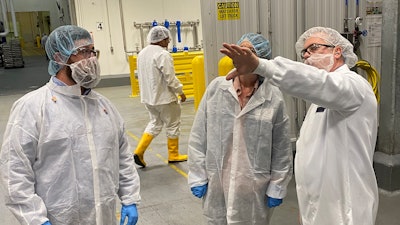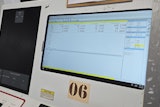
Kerry Group, a food company with 147 manufacturing facilities worldwide, implemented a sustainable bone broth approach to reduce chicken waste.
In a case study, Kerry explains how it introduced an idea to a customer to help eliminate waste and create a product that sends zero waste to landfills. The idea resulted in a process that separates broth from fat and bone residue, the latter of which goes to customers in the food, pet and fertilizer industries.
Food Manufacturing toured Kerry’s 120,000-square-foot facility in Harrisonburg, Virginia, and followed up with Plant Manager Dominic Locke and North America Director of Sustainability Christina O’Keefe, who elaborated on the process.
Nolan Beilstein (NB): How does the sustainable bone broth process work?
Dominic Locke (DL): Kerry’s strategic focus is to provide our customers with the opportunity to create value through upcycling waste into taste. Our Stocks & Broths manufacturing in Harrisonburg, Virginia is a great story of sustainability and circular solutions, where we use every part of the chicken that enters our plant and nothing goes to waste.
The poultry industry starts with whole carcasses that are then broken down into primal cuts of whole breasts, legs, thighs and wings, which are available to the consumer. We source deboned carcasses as part of our commitment to responsible sourcing and reduced environmental impact, which we break down further, separating the material into chicken and crushed bones, which flow into two separate streams.
The chicken is cooked and further processed into broth and fat. The fat goes through another heating step and is sent to customers in the food and pet industries.
The bone broth is then filtered, combined and gently cooked under pressure to extract richness, clean label savory taste and succulence. This process mimics how you would create a broth at home using a pressure cooker. We then blend in Kerry organic flavors, vegetable broths or science backed ingredients per customer requirements.
The crushed bones are used in fertilizer. Resulting in every part of the chicken carcass being upcycled and used in the full circular solution.
NB: How did the idea form?
DL: We understood the importance of our role in sustainable nutrition in serving the poultry market and the essential revenue stream for poultry processors across North America. We also knew our customers face complex challenges from consumers, who were demanding more from their products, driving rapid change in the food and beverage industry.
Kerry’s sustainable nutrition focus was the vehicle driving innovation towards a closed-loop process. With our experienced teams across sustainability, regulatory, R&D, engineering and operations, we quickly identified multiple opportunities across our process to maximize our potential for upcycling certification and to deliver a circular solution. Through the process, we were able to help our customers make the claims consumers are looking for, including clean label, organic, responsible sourcing, health and wellbeing, in a fully sustainable process.
NB: How far does the impact of the recycled bones extend?
DL: Our impact extends all the way back to the start of the food chain, in that, natural by-products from our stocks & broth manufacturing process are used as fertilizers which replenish nutrients and restore soil fertility for the next generation of successful agricultural endeavors.
NB: Has Kerry calculated an environmental impact?
Christina O’Keefe: Our goal at Kerry is to reach over two billion people with sustainable nutrition solutions by 2030, and our plant in Harrisonburg plays a big part in achieving this goal.
Kerry has committed to a 55% reduction in operational carbon emissions by 2030, aligned with the Science Based Target Initiative.
Along with this operational carbon reduction, Kerry has already achieved 100% renewable electricity in manufacturing and continues to optimize operations for eco-efficiency and local sourcing – 50% of poultry is sourced within 3 miles from the Harrisonburg facility.























